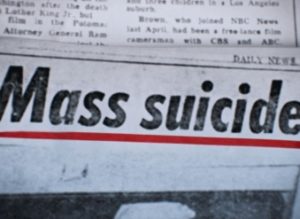 “Did you have dreams about being in the jungle yet?”
“Did you have dreams about being in the jungle yet?”
The question came from a university professor I was meeting with before starting filming my documentary, The Jonestown Massacre, for French-German network Arte. He had been working on Jonestown and Peoples Temple for years. I had been working on it for just a few months. But I knew exactly what he meant. I had no dreams about being stuck in the jungle but I was stuck in the maze of a story that would turn out to be more complex and haunting that I could possibly imagine.
My film was to be part of a series of ten history documentaries about important news stories and what they say about the times and society in which they happened. The purpose of my episode about Jonestown was to highlight how the story of Peoples Temple mirrors the US of the sixties and seventies but, more globally, how it echoes American history.
We started with how the story of the mass suicide was narrated to the American public: an “atrocity tale,” as John R. Hall, author of Gone From the Promised Land, would explain it, “a form of myth making in that it takes historical facts or social facts and puts them into a frame that is a frame of good versus evil.” Indeed, nine years after Charles Manson, the figure of the devil is back on the front page in the form of Jim Jones. And as the similar headlines of Time and Newsweek would suggest, what happened in Jonestown would be mainly reduced in the media to a story of a “Cult of Death.”
Then we focused on what Peoples Temple was and how it might have embodied everything America was starting to reject in the late seventies, before the country elected the conservative Ronald Reagan to the White House, to the point that some states refused to accept the bodies for burial within their borders because they feared they would “poison the ground” (with its obvious symbolic charge): communists, of course, but also a community that was the symbol of counterculture. A church that preached racial, social and gender equality. A group on a mission to fix America’s flaws and who, as Professor of Social Psychology and Psychoanalyst Enrico Pozzi would analyze, “by dying together became what the American society isn’t: a perfect community, the achievement of utopia through death.” Before, they would follow Jones, who played the role of the “black messiah,” the providential man who would heal the wounds of African-Americans and take them, like the pilgrims who fled persecution, to the Promised Land. The “manifest destiny” by any means necessary…
As a conclusion, the documentary focuses on how the story of Jonestown ties two fundamental elements of American history: faith and violence. With Waco, an aftermath of Jonestown, it would be the same scenario of a fight between good and evil. And eventually, contemporary apocalyptic cults, such as Isis and Al-Qaeda can be considered on some levels, as the modern and extreme version of an ancestral aspiration: the end of times, the end of an imperfect world.
At some point in my documentary, I show a clip from NBC’s footage on the eve of the tragedy. All the members of Peoples Temple are gathered in the pavilion, cheering the entertainers as they sing an uplifting soul song while children laugh, a scene reflective of numerous others in numerous homemade Super 8 movies filmed by Peoples Temple in Jonestown. This time the celebration and the joy seem bigger. Maybe because it’s staged for Leo Ryan and the journalists who traveled with him. Nonetheless, these are images of people celebrating something they created and believed in, hundreds of people who will all die less than a day later.
These images, for me, sum up how vertiginous Jonestown is. Because it isn’t just about a manipulative mad guru who led some gullible weak people to death, end of story. That’s the thing with Jonestown: there seem to be no easy “end of story.”
(France Swimberge is the director of La tuerie de Jonestown, une apocalypse américaine, which may be seen here [password FDJONES].)